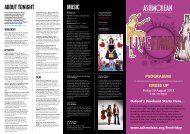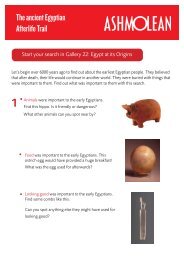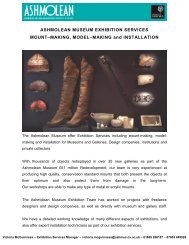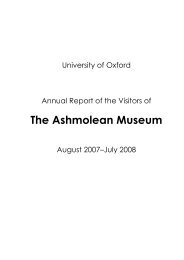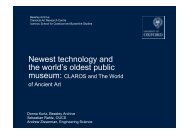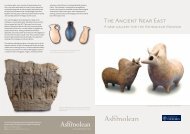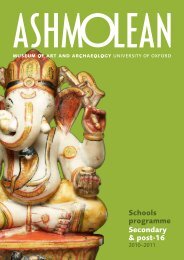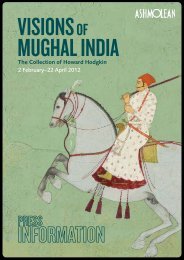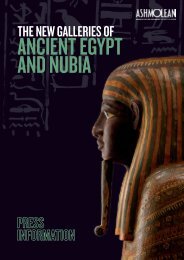The Bronze Age: Canaan - The Ashmolean Museum
The Bronze Age: Canaan - The Ashmolean Museum
The Bronze Age: Canaan - The Ashmolean Museum
Create successful ePaper yourself
Turn your PDF publications into a flip-book with our unique Google optimized e-Paper software.
ANCIENT NEAR EASTERN TERRACOTTAS<br />
usually identified as papyrus. Her feet point sideways, not forwards. This type of plaque does not appear<br />
to have survived in <strong>Canaan</strong> after the end of the <strong>Bronze</strong> <strong>Age</strong> (unlike the ‘Astarte’ type). This type of nude<br />
female occasionally appears, on metal and terracotta plaques, associated with animals: the lion and the<br />
horse (Keel and Uehlinger 1998, 66–7, figs 70–73). This is the strongest evidence for the nude female in<br />
this category representing a goddess or her cult image through her divine identity might have varied<br />
amongst a range of possible “Mistresses of Animals” (cf. Wiggins 1991); but without a “familiar” animal<br />
or divine headdress she might be a suppliant to the goddess rather than the goddess herself.<br />
(2) Type B: Astarte Plaques (cf. no. 300A)<br />
This category, again a term of convenience, also depicts full-frontal nudes framed by a groove or ridge<br />
round the end of the plaque, which is comparable in shape to the previous type. Both types might have<br />
been laid flat, propped up or held in the hand; none is self-supporting. On this type the hairstyles vary,<br />
with the occasional appearance of headdresses. <strong>The</strong>re are a number of different arm positions: held down<br />
the sides with hands touching hips (the commonest position on comparable figurines in Egypt); with<br />
hands cupped under the breasts, sometimes as if displaying or offering them; with both hands placed on<br />
the abdomen, which is sometimes slightly bulging as in pregnancy; with one hand held downwards<br />
touching or indicating the genitals and the other bent at the elbow with the hand on a breast. On this type<br />
the feet are commonly together, pointing forward. <strong>The</strong>y have no attributes. This type survived into the<br />
Iron <strong>Age</strong>.<br />
Miram Tadmor (1982) has argued that the figure is represented as if reclining and is most commonly<br />
found in tombs, consequently relating them to the so-called “concubine figures” of Egyptian tombs and<br />
to limestone examples from the cemetery at Deir el Balah (Dothan, T. 1979). But Keel and Uehlinger<br />
(1998, 100ff.) have demonstrated that eighty per cent of published Late <strong>Bronze</strong> <strong>Age</strong> graves do not include<br />
clay plaques and even when they appear in family graves, there are only one or two. <strong>The</strong> vast majority,<br />
complete and fragmentary, are recovered from family living quarters or in debris. When they appear in<br />
graves it is then as “household goods”, in common with the other ceramic equipment. Moreover, Pinch<br />
(1983) has convincingly deconstructed the old arguments for identifying such figurines as “concubines”<br />
in Egyptian tombs, not least since they are not invariably associated with male skeletons in graves there.<br />
Few questions in the study of terracottas in the ancient Near East, as will be evident from the earlier<br />
section on the Babylonian nude female plaques, is more difficult to resolve and therefore more contentious<br />
than the problem of her (or their) identity when no attributes identify a goddess. Keel and Uehlinger<br />
(1998, 108) take the radical approach by arguing that: “the modern question about whether a figurine<br />
represents a goddess or a woman, posing strict alternatives, is too short-sighted. <strong>The</strong> plaques portray the<br />
goddess as a woman, and conversely they identify the female worshippers... with the goddess.” <strong>The</strong>re is,<br />
however, no unambiguous evidence that they were exclusively associated with women rather than with<br />
men, who also petitioned goddesses in the context of sex and family life. Moreover, it is not evident that<br />
the modern concept of a “role model” is appropriate even for women. Ancient goddesses, particularly<br />
Ishtar (who was also a warrior goddess) and her cognates in the Levant, had diverse functions and may<br />
have been worshipped by men and women for different purposes. Van der Toorn (1998, 94) conceived<br />
these images as “reflections of official cult images or symbols, used outside the cult for devotional and<br />
prophylactic purposes”. This would accord with the view of some Egyptologists that contemporary<br />
popular imagery showing divinities there represent well-known cult images of them, not the deity him or<br />
herself (cf. Schulmann 1981).<br />
This line of argument would be strengthened if it could be demonstrated that the “frame” does not<br />
represent the edges of a bed, but rather an architectural feature. In other words, she stands rather than<br />
reclines, as indeed the feet together, facing forward, is seen to indicate in other contexts when the nude<br />
female is set on a small podium. This would then present the image set in a shrine. Keel and Uehlinger<br />
(1998, 101–105) have explored this possibility in the light of some ceramic plaques of such shrine fronts<br />
in which the clearly depicted architectural elements confound any suggestion that these figures recline<br />
-186-




